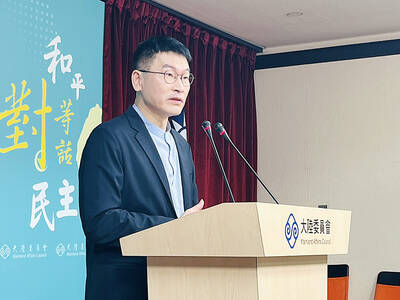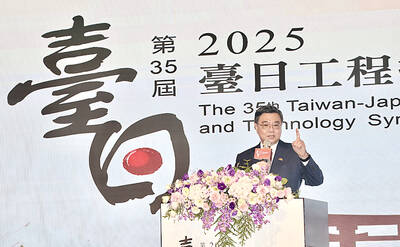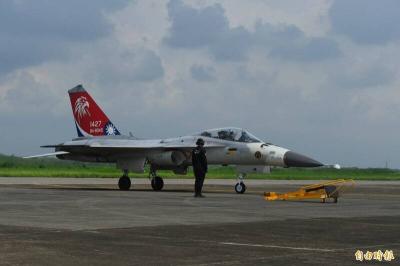Saying that it was impossible for Taiwan and China to recognize each other based on their respective constitutions, Chinese Nationalist Party (KMT) presidential candidate Ma Ying-jeou (馬英九) proposed yesterday that both sides of the Taiwan Strait acknowledge what he termed "mutual non-denial."
Ma said the KMT supports the idea of each side of the Strait having its own interpretation of "one China." He said that as long as China and Taiwan could reach the status of what he termed as "mutual non-denial," they would spontaneously refer back to the so-called "1992 consensus."
"This [mutual non-denial] is the minimum requirement," Ma told reporters during a visit to Humayun's Tomb in New Delhi on the second day of his two-day trip to India.
"If we could put aside controversies through this [mutual non-denial] format, we could jointly address the more urgent and substantial issues," he said.
Ma said the idea of "mutual non-denial" could not be used to resolve the cross-strait stalemate immediately. It could be used as a first measure to change the attitudes on both sides and create more room for discussion, he said.
"The pursuit of legal independence is the pursuit of an illusion," he said.
"Those who pursue this will have big disappointment once they are disillusioned," he said.
Commenting on Ma's remarks, Democratic Progressive Party presidential candidate Frank Hsieh (謝長廷) said in Taipei yesterday: "Taiwan does not deny China, it is China which is denying Taiwan's international space."

LOW RISK: Most nations do not extradite people accused of political crimes, and the UN says extradition can only happen if the act is a crime in both countries, an official said China yesterday issued wanted notices for two Taiwanese influencers, accusing them of committing “separatist acts” by criticizing Beijing, amid broadening concerns over China’s state-directed transnational repression. The Quanzhou Public Security Bureau in a notice posted online said police are offering a reward of up to 25,000 yuan (US$3,523) for information that could contribute to the investigation or apprehension of pro-Taiwanese independence YouTuber Wen Tzu-yu (溫子渝),who is known as Pa Chiung (八炯) online, and rapper Chen Po-yuan (陳柏源). Wen and Chen are suspected of spreading content that supported secession from China, slandered Chinese policies that benefit Taiwanese and discrimination against Chinese spouses of

ALIGNED THINKING: Taiwan and Japan have a mutual interest in trade, culture and engineering, and can work together for stability, Cho Jung-tai said Taiwan and Japan are two like-minded countries willing to work together to form a “safety barrier” in the Indo-Pacific region, Premier Cho Jung-tai (卓榮泰) yesterday said at the opening ceremony of the 35th Taiwan-Japan Modern Engineering and Technology Symposium in Taipei. Taiwan and Japan are close geographically and closer emotionally, he added. Citing the overflowing of a barrier lake in the Mataian River (馬太鞍溪) in September, Cho said the submersible water level sensors given by Japan during the disaster helped Taiwan monitor the lake’s water levels more accurately. Japan also provided a lot of vaccines early in the outbreak of the COVID-19 pandemic,

PROMOTION: Travelers who want a free stopover must book their flights with designated travel agents, such as Lion Travel, Holiday Tours, Cola Tour and Life Tours Air Canada yesterday said it is offering Taiwanese travelers who are headed to North America free stopovers if they transit though airports in Japan and South Korea. The promotion was launched in response to a potential rise in demand for flights to North America in June and July next year, when the US, Canada and Mexico are scheduled to jointly host the FIFA World Cup, Air Canada said. Air Canada offers services to 13 of the 16 host cities of the tournament’s soccer games, including Toronto and Vancouver; Mexico City, Guadalajara and Monterrey in Mexico; Atlanta, Georgia; Boston; Dallas; Houston;

The US approved the possible sale to Taiwan of fighter jet spare and repair parts for US$330 million, the Pentagon said late yesterday, marking the first such potential transaction since US President Donald Trump took office in January. "The proposed sale will improve the recipient's capability to meet current and future threats by maintaining the operational readiness of the recipient's fleet of F-16, C-130," and other aircraft, the Pentagon said in a statement. Trump previously said that Chinese President Xi Jinping (習近平) has told him he would not invade Taiwan while the Republican leader is in office. The announcement of the possible arms